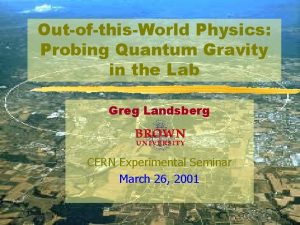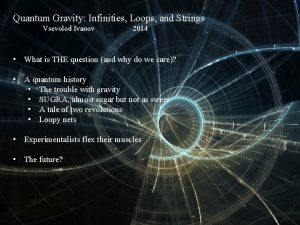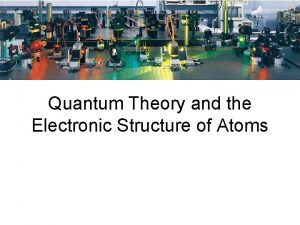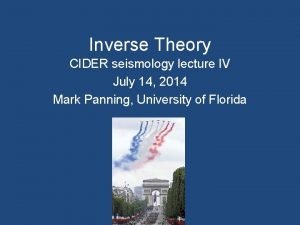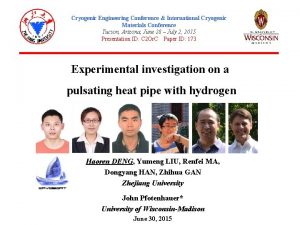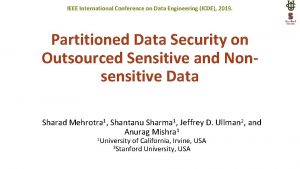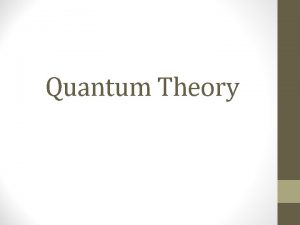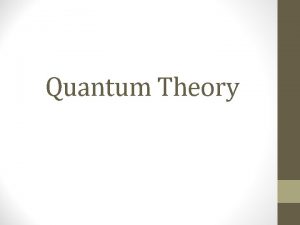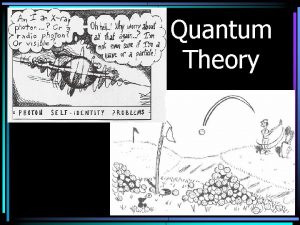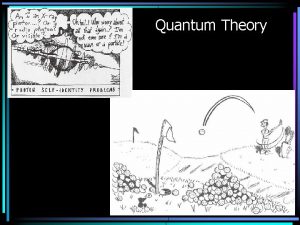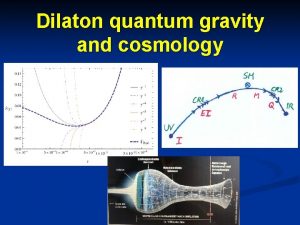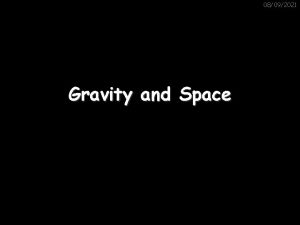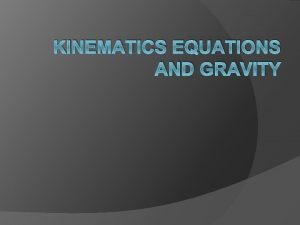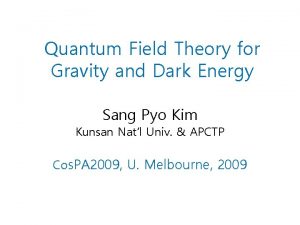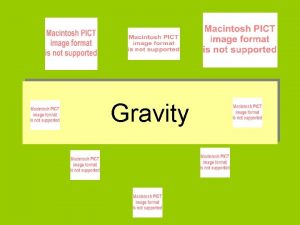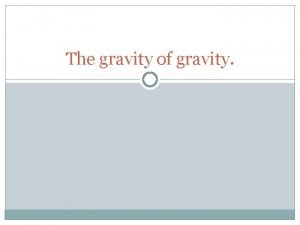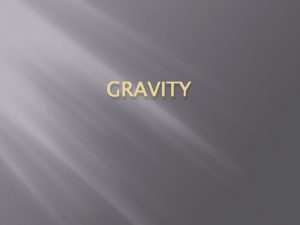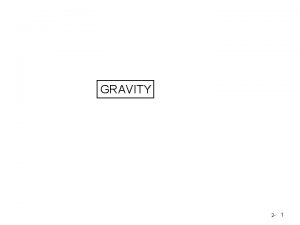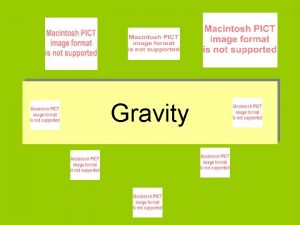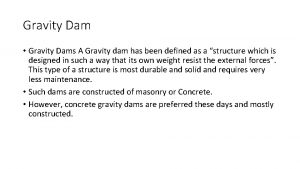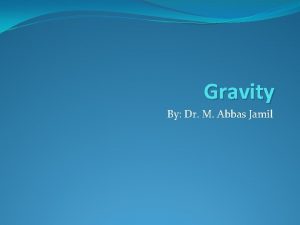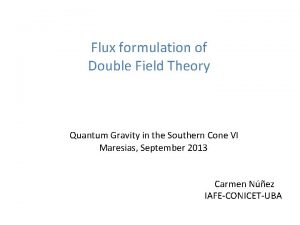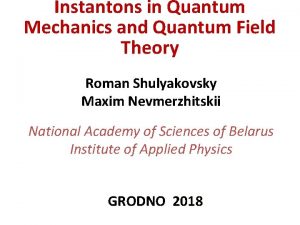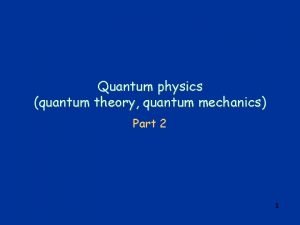International Conference QUANTUM FIELD THEORY AND GRAVITY Yu

























- Slides: 25

International Conference QUANTUM FIELD THEORY AND GRAVITY Yu. Kunashenko Tomsk State Pedagogical University, Russia Coherent production of electron positron pairs in channeled state by photon

Motivations When the relativistic charged particle penetrates through an aligned crystal there are coherent interaction and channeling effect. Coherent effect in the particle interaction with a crystal arises due to periodical arrangement of the crystal atoms, the interaction amplitudes with individual atoms are summing up in a phase. As a result the cross – section has coherent peaks at fixed parameters (energy, angles of incidence). Channeling phenomenon takes place when the relativistic charged particle passes through crystal at small angle with respect to crystal axis or plane and the crystal thickness is rather large, so that the Born approximation does not work. In this case a charged particle interacts with continuous (averaged) potential and one can neglect the periodic part of the crystal potential. Longitudinal (parallel to crystal axis) motion is free while transverse motion occurs in a continuous potential. Therefore, the channeled particle has the transverse discrete energy levels. It is obviously that there is not sharp boundary between coherent and channeling effects. One can consider conditions when both effects occur simultaneously. Photoproduction of electron – positron pairs in the continuous potential of the crystal axis and coherent photoproduction of electron – positron pairs arise at the same incident angles of the photon into the crystal. During the coherent process the electron can be created in a channeled. _______________________________________ Ter-Mikelian M. L. , High Energy Electromagnetic processes in Condensed Media, Wiley Interscience, New-York (1972). Baier V. N. , Katkov V. M. and Strakhovenko V. M. , Electromagnetic Processes at High Energies in Oriented Single Crystals, World Scientific Publishing Co, Singapore (1998). Lindhard J. , Influence of Crystal Lattice on Motion of Energetic Charged Particles, Mat. -Fys. Medd. Dan. Vid. Selsk. 34, No 14 (1965) 1 -64.

Kinematical consideration Let photon enters into crystal with momentum parallel to crystal axis. The conservation laws of energy and longitudinal momentum are photon energy and momentum, is a momentum of created positron (electron), is a reciprocal lattice vector, m is an electron rest mass. are transverse energies of positron and electron After substitution of Eq. (1) into Eq. (2) we find photon energy of the coherent peak _______________________________________ Kunashenko Yu. P. and Pivovarov Yu. L. , "Brilliance of coherent peaks for type-B photoproduction of electron-positron pairs in a crystal"// Nuclear Instruments and Methods in Physics Research B, 114 (1996) 237 -244.

Dirac Equation Potential of crystal axis We expand crystal axis potential in Fourier series The first term of the expansion is the continuous potential of crystal axis The z dependence axis potential is taken into account by the coefficients are reciprocal lattice vectors, with k an integer, az is the distance between atoms along the crystal axis and z 0 is arbitrary.

Dirac Equation We shall seek the solution of the Dirac equation in following form After substitution wave function into the Dirac equation we obtain When we neglect the small terms

Dirac Equation Expanding Substituting into the Dirac equation, comparing the terms with the same k, we find Here we take into account

Dirac Equation Solution of the Dirac equation for continuous potential The Dirac equation for transverse motion is Acting with operator one obtains the second-order Dirac equation with the usual Sommerfeld-Maue-type approximate solution where is the solution of the equation

Dirac Equation We choose crystal axis continuous potential Using coordinates. We obtain equation

Dirac Equation The solutions of differential equations for continuum states are . and for bound states are is the confluent hypergeometric function, the Kummer function.

Dirac Equation Now we have wave functions for the continuum states of positron are . and for the bound states of electron are Here u± are the free Dirac spinors.

Cross – section The cross section for pair production is given by The matrix element After substitution of wave function into matrix element we obtain The matrix element is a sum of tree terms contains corrections of a higher order of smallness and can be neglected

Cross – section Describes electron- positron pair photoproduction in continuous potential H. A. Olsen and Yu. P. Kunashenko, Dirac states of relativistic electrons channeled in a crystal and high-energy channeling electron-positron pair production by photons. // Phys. Rev. A 56 (1997) 527.

Cross – section depends from reciprocal lattice vectors and therefore, describes coherent electron – positron pair photoproduction

Cross – section When the sum over electron and positron polarizations and the average over photon polarizations are performed we find Here the following notations are introduced:

Cross – section

Cross – section In the high energy limit Here the following notations are introduced:

Cross – section The integral Here is equals to is longitudinal transferred momentum and We use following approximation for Fourier component of axis potential and find

Cross – section The differential cross-section of the coherent photoproduction of e+e- pairs with the capture of electron on Nth energy level (N=n 1+n 2) of the transverse motion is If

Cross – section If the photon enters into crystal parallel to the axis After integration cross - section using δ – functions we find

Cross – section From this formula follows that the transverse momentum of the positron is quantized Integer numbers k 1, k 2 define the reciprocal lattice vector, which contribute to the crosssection Here pmax is maximal transverse momentum of created positron. The value of pmax is connected with maximal emission positron angle with respect to crystal axis

Cross – section The matrix element depends on quantum numbers of the bound state of created electron. Transverse electron energy levels with quantum numbers N is degenerate. Therefore it is necessary to sum the contributions to the cross-section over all states with the given transverse energy. The photon energies at which the coherent peak appears are equal to If we neglect transverse energy we get the usual formula for coherent position _______________________________________ Kunashenko Yu P “Coherent production of electron-positron pairs in channeled state by photon”// Nuclear Instruments and Methods in Physics Research B 402 (2017) 49– 53

Cross – section It is shown the energy dependence of the crosssection of coherent photo-production pairs with the capture of the electron in the bound state with the crystal axis. Solid line corresponds to N=5 , dotted line corresponds to N=10 and dashed line corresponds to N=15. The target is Si <100> crystal, NSt = 103, is the maximum angle positron emission. The arrows indicate the positions of the coherent peaks according to the ordinary theory of coherent pairs photoproduction.

Cross – section N=0 up to N=15. It is shown the dependence of the coherent electron – positron photoproduction pairs with the capture of an electron in in the bound state with the axis cross-section summed over the transverse energy of the electrons from N=0 up to N=15. The arrows indicate the positions of the coherent peaks according to the ordinary theory of coherent pairs photoproduction.

Conclusion Detailed theoretical consideration confirms the conclusions based on the simple kinematic estimations, that the channeling effect of the created particle significantly change the picture of coherent photoproduction of electron – positron pairs in the crystal. The calculations do not take into account thermal vibrations of atoms in a crystal. It is well known that the average of cross-section over thermal vibrations results in: 1) the appearance of the incoherent part of the cross-section; 2) decrease the value of coherent peaks due to the Debye-Weiler factor.

Thank you
 Gravity for dummies and dummies for gravity equations
Gravity for dummies and dummies for gravity equations Similar image search
Similar image search Loop quantum gravity
Loop quantum gravity Classical physics
Classical physics Quantum physics vs quantum mechanics
Quantum physics vs quantum mechanics Magnitude of magnetic force
Magnitude of magnetic force Q factor of capacitor
Q factor of capacitor Data types and field properties
Data types and field properties Field dependent and field independent
Field dependent and field independent Difference between electric field and magnetic field
Difference between electric field and magnetic field The lowest allowable energy state of an atom
The lowest allowable energy state of an atom Electrons in atoms section 2 quantum theory and the atom
Electrons in atoms section 2 quantum theory and the atom Quantum theory and the electronic structure of atoms
Quantum theory and the electronic structure of atoms Gravity theory cider
Gravity theory cider International cryogenic engineering conference
International cryogenic engineering conference International gambling conference
International gambling conference Sae international conference
Sae international conference Ieee international conference on data engineering
Ieee international conference on data engineering Parvuli dei activity book
Parvuli dei activity book International space development conference
International space development conference International conference on fish telemetry
International conference on fish telemetry Aamva international conference
Aamva international conference Cometva
Cometva Cit healthcare conference 2017
Cit healthcare conference 2017 Asbo international conference
Asbo international conference Field dependent vs field independent
Field dependent vs field independent

